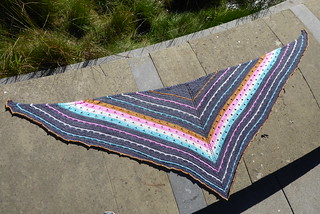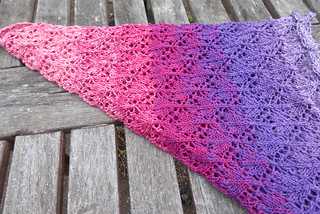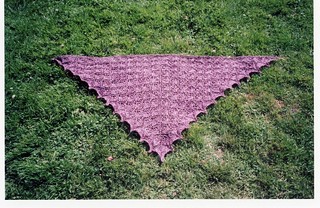You are currently browsing the category archive for the ‘Shawls’ category.
If you are looking for knitting that brings you suspense! excitement! anxiety!, a project that keeps you on the edge of your seat 4 times as you watch the balls of yarn get smaller and smaller with each passing row, I will steer you toward the Andy shawl:
I totally won at yarn chicken in this, 4 times, ha! I have a yarn butterfly each of the gold and aqua yarns, and only a wee bit more each of the pale gray and pink, remaining. This is my first project with mini skeins and I’m not sure I can handle this level of excitement a second time, because yarn chicken comes with risks: you never know whether you will beat the chicken, or it will beat you.
I bought the pattern and yarn as a kit, together with project bag, at Stitches West in February. The kit colors differ from the pattern colors and I printed the pattern in black and white, so I took a black-and-white photo of the yarns to help me choose the order in which to knit the colors:
CC1 in the original colors is the darkest. For me, that was Wish You Were Beer (gold).
CC2 is 2nd lightest: Barbie Girl (pink).
CC3 is lightest: Jackie O (pale gray).
CC4 is 2nd darkest: Set Sail (aqua).
This shawl starts at the top with a garter tab and works out to the point. The pattern has you change the order of the colors in the third color section, I presume so you can have enough of CC1 to finish the border. The designer contradicts herself on page 2, stating gauge is important and is not important; I can clarify that gauge is important if you have these particular mini skeins and intend to have enough yarn to finish, not important if you have more yarn. In that case, as usual with shawls, your gauge is perfect if you like the drape of what’s coming off the needles.
Pattern: Andy by Laura Dobratz (Ravelry link) — I used version 3 of the pattern.
Yarn: Emma’s Yarn in two put-ups, 80% merino, 10% cashmere, 10% nylon.
Main color: Hella Hank (large): .9 skein, 135g / 540 yards of Thanks 4 Noticing Me.
Contrasting colors: Practically Perfect Smalls: nearly all of 20g / 87 yards each of Wish You Were Beer, Barbie Girl, Jackie O, Set Sail.
Needles: US size 6
Size: 72″ across and 25″ tall
Started 7/31 and finished 8/13/2020
Two minor deviations from the pattern: I worked row two of the main color’s border section in knit instead of purl (to make a narrow garter stitch edge instead of stockinette), and I didn’t pin out the picot points when blocking because I don’t have a large enough blocking surface, so they curl a bit. The pattern is written out, not charted, and I needed a marker only on the center stitch. I found it helpful to circle the (k1) that was the center stitch to help me keep my place.
The shawl is a size I like, is soft and comfortable, and reminds me of ice cream with caramel sauce.
Looking out at the gloomy, very windy day today (seriously windy… entire building is shaking so much that it mimics a mild earthquake), I decided to stay in and write up my notes for projects I made months ago. One is the Flower Basket Shawl that I made with the yarn I got at Stitches West’s (remember the days of in-person gatherings?) pajama party:
Pattern: Flower Basket Shawl by Evelyn A. Clark, as published in Interweave Knits, Fall 2004 (Ravelry link)
Yarn: 135g and 560 yards Red Heart It’s A Wrap Rainbow, 55% acrylic, 45% cotton, in color Parfait
Needles: US size 6
Size: 60″ across top, 27″ tall
Started 3/29 and finished 4/17/2020
The pattern has you start at the top center and work downward, increasing all the way. As the giant skein started winding down into the paler purple, I ran a lifeline after each pattern repeat so I could knit to nearly the end of the skein. When the yarn ran out, I ripped back to the last lifeline, confident I had enough to finish the border. The result is 14 repeats total and 90% of the yarn used; the 15g remaining is not enough to work another repeat and went in the scraps bin.
I did not enjoy working with this yarn. Its construction is 4 skinny strands barely plied together, running almost parallel, which meant my needle kept trying to slip between plies rather than catch all 4 strands at once. I had to rescue left-behind strands from a row below with a crochet hook too many times. When I got to the first color change, I realized the reason for its construction:
It’s not a gradient. At each color change, one strand is swapped out and knotted together with the next color. Ugh, it meant I had to leave 2 tails at each single-strand color change — so many ends to weave in! From a yarn factory’s perspective I imagine it’s easy to have the machine do the chop and knot at regular intervals and it probably saves money to not really ply it; for the knitter, it’s a gripe. The strand was only slightly longer at the knot, which meant I had to pull it longer to leave enough tail to weave in for both strands, which meant that particular ply was now a good bit shorter than the other 3, which meant I had to run my hand over a length of working yarn constantly throughout the project to bring the plies into alignment, leaving a little bunched-up puddle of yarn barf sitting on top of the skein. Fortunately, it’s not a clingy yarn so it was only a minor annoyance.
Unblocked, the Flower Basket Shawl in this yarn has a texture I quite like:
This bodes well for wherever it ends up living someday, no severe pinning required for it to look good. When blocking, I deliberately did not pin the border points, so they curl up a bit.
My dislike of the yarn’s construction notwithstanding, this Flower Basket Shawl came out well. The yarn is a better yarn choice than what I picked for the one I made for me in 2005, a strand each in 2 colors of alpaca held together, in which the lace pattern is muddled-looking.
Mine is warm, but not stunning.
I’m working on Celestarium, a circular pi shawl that’s a bead-studded map of the major constellations of the night sky in the northern hemisphere, and around the time I took this progress photo, while I was fishing around a bowl of beads with a tiny crochet hook in an attempt to spear one, a fellow knitter asked me, “How often do you have to put in a bead?”
My reply: “When the stars line up. And I mean that literally.”
Thinking figuratively, though, it’s about how often I write here at Mmm… Yarn. As most avid crafters know, there’s just so much to do with so few crafting hours in the day that certain things must fall by the wayside.
Stitches West is in less than 2 weeks. I started the border on Celestarium yesterday and am about 20% done. Easy-peasy to get it done in time to wear it at the Market, although it may have to go non-blocked because of how cold it is in the apartment. Cold room = things don’t dry.
It’s not that cold, really and truly. Behold, our “snow”:
Rubber bands… they convert 7″ double points to straights and gather the fabric to keep 117 stitches worth of Kimono Shawl in progress from falling off the technically too-short needles.
If I break one, no problem. They come free with takeout menus that I find hanging on the building doorknob a few times a week, which means I have an endless supply. And I’m always surprised to find knitters out there who don’t know this trick.
Blooming bougainvillea courtesy of a neighboring building.
No, actually, I don’t think there is a better way. For straight-edged shawls I adore using the blocking wires, but for scalloped and lacy edges, a million pins is the way to go.
This method means two nights of pinning, though, one evening for each half o’ Haruni, because I apparently own only half a million pins (give or take a dozen).
Seeing the aurora borealis is on my list of “someday” travel dreams. It’s only been on the list for a year and I didn’t actively pursue it once I thought it up because brrrrr, the weather is usually on the cold side once you’re far enough north to see the lights. However, I could make it up in knitting: Revontuli, the northern lights shawl, has been on my mind pretty much since I first spotted it on Ravelry and in December I made it.
The barrier is made of a grabby type of stone (sandstone, perhaps?) that is wide enough to accommodate shawls and holds them in place while you photograph them. I’m sure this is exactly the purpose the parks department had in mind here.
The pattern uses increases and decreases to create the zigzags. I made it nearly one pattern repeat longer than written and used size 11 needles to work a suspended bind-off in knit on the last row. Despite the long rows to purl back, I made this quickly because I liked seeing the stripes appear.
Pattern: Revontuli-huivi/Northern Lights by AnneM
Yarn: 2 skeins Lang Yarns Jawoll Magic Dégradé, color 85.0025
Needles: US size 9
Size: 64″ across top and 28″ tall
Started 12/8 and finished 12/28/2012
This is souvenir yarn I bought in Bad Sooden-Allendorf last fall when I stopped for lunch on my way elsewhere. I knew Lang Yarns in general are available in the United States but I really liked these colors so snapped up two skeins because I had the opportunity.
It’s big enough to fit the lion sphinx.
I’ll have to wear it whenever I do make it to the far north in honor of the occasion, probably over something else so my neck stays super-warm.
I joined the more than 10,000 other knitters on Ravelry who have made a Citron shawl/shawlette and made one, too. Mine is a purple wedge of citrus:
Pattern: Citron by Hilary Smith Callis, as published on Knitty, Winter 2009
Yarn: Creatively Dyed Yarn Calypso, 100% merino wool, color Aruba
Needles: US size 6
Size: 46″ wide across top and 16″ tall at center
Started 4/21 and finished 4/25/2012
This was a quick knit but felt like it took far longer than 4 evenings; those ruffled rows contain a lot of stitches. I wanted to make it one repeat longer but did not have enough yarn (fortunately, had just enough yarn left to turn out a pair of booties). It turned out a little small but my statuesque model is able to wear it wrapped:
In keeping with the fruit theme, I also made some fruit socks earlier this year. No pattern here, just cast on, increased, ribbed, made drawstring holes, then increased for the little ruffle on top before casting off. I gave one to my co-worker who happily uses them for apples and hard-boiled eggs. The rest will go to the craft fair I’m participating in next month.
Pattern: own
Yarn: Brown Sheep Cotton Fleece in CW-380 Dusty Sage, Cascade Yarns 220 Superwash in 844 (purple), James C. Brett Marble Chunky in MC10 (blue) and MC23 (blue-green), Wolle Rödel Soft-Merino in 316 (purple)
Needles: US size 5 and 8
Started 3/31 and finished 4/13/2012
They look pretty lined up with their apples inside them:
No reason for the recent blog hiatus except I’ve been knitting more (at 9 miles of yarn this year already!), reading more, and sitting at the computer less. I also went on a just over 3-week vacation in September/October, my first one in 4 years. It was time. My days were so busy that I knitted only on the airplane and it turned out to be something I had to rip out and start over after I got home.
This was supposed to have been a quick, 1-weekend woven scarf project using a skein of Tofutsies. Today I’m unweaving it for the second time.
Gads, but the unweaving is tedious and disheartening. I now have little desire to finish this project. Why undo it? Well, the first time around I beat each row with my usual force and it turns out that was too tightly: I was more than halfway through my yarn supply for the warp and had only 6 inches of scarf, so I unwove and tried again, beating more gently. This time I managed to get about halfway through the length but can see I definitely won’t have enough yarn to finish so I have to undo it and beat it more gently still. I saw this as a sample scarf at Stitches West a couple of years ago so I know it can be done with one skein. I do wonder how I’m supposed to keep the row that’s up against the beam straight whenever I advance the warp when I’m weaving this loosely. It goes wonky every time. You can see one of those wonky rows just above where the shuttle is parked.
I suppose a smarter choice would be to attempt to scare up a second ball of this dye lot. Hmph.
In knitting news, I’m plodding through some more baby booties and basic novelty yarn scarves. I went away for a week to Oregon and needed airplane and mindless knitting and these projects served that purpose. My mom’s sweater is on hold because I can’t get my brain focused on the basic calculations needed to figure out the neckline. Silly, but there you have it.
Hanging on the wall at my grandmother’s house in Oregon is this needlepoint canvas I stitched for my grandparents when I was 12. I took a photo of it for posterity:
My impression now: good execution and wow, does that yarn not fade over the years. I think it’s acrylic. Also a not-to-my-taste design. Not to my grandmother’s household’s taste, either (it kind of stands out), but she has it in the dining room where it gets seen a lot.
Tucked away in a closet, called “too good to use,” is the feather-and-fan stole I knitted for her for Christmas 2001. Darn. I had made it for her to wrap up when in bed reading and hoped then she’d actually use it. I encouraged her to use it when I saw her last week. I have a feeling it went back in the closet after I took it outside for a photo shoot. The pattern is Theatrical Lace by Eugen Beugler and the yarn is Brown Sheep Cotton Fine.
My impression now: I still like it! The blue is darker than it appears in the photo.
My 18g spindle survived its plane journey tucked in its wine box in the suitcase. I taught my aunt and uncle to spin while my grandmother chose to observe. A couple of days later we went to the Thomas Kay Woolen Mill (museum) and saw how big spinning machines worked at this now defunct mill. My aunt and uncle said the spindle lesson made the mill tour make more sense to them. Me, I am in awe of how fast spinning and weaving machines can work.
A few months ago I went to the yarn shop and liked a sample scarf knitted up in Noro Kirameki. I bought the yarn and ended up making something completely different with it, and something crocheted at that.
Pattern: Half Granny Square Shawl by Anastacia Zittel
Yarn: 1 skein Noro Kirameki Singles, 60% rayon, 25% nylon, 10% wool, 5% cashmere, color 152
Hook: size G (4mm)
Size: 58″ across the top and 28″ from top to point
Started 1/8 and finished 1/26/2012
I didn’t understand the first couple of rows of the instructions. I made the chained ring, fiddled with the first row or two and ripped it out multiple times, then ignored the instructions and made three shells in the ring. That worked and I could get going on the first real row.
The yarn is clingy, sticks to itself firmly. This was good for not losing the last dozen stitches when I threw the shawl into my messenger bag and the hook fell out, and bad for when I discovered a mistake a few rows back and had to rip. Luckily that only happened a few times and I only broke the yarn once trying to tug it free while ripping. It reminded me that one of the reasons I like knitting better is I can usually drop down just the few affected stitches to fix a simple mistake. When crocheting your only choice is to rip back entire rows. Well, you could also repeat the mistake and call it a design feature.
It blocked out nicely. If you want yours to block out wider at the top, make those chains when turning a row looser than I made mine. Mine are a little tight.
I’m crocheting a shawl that is rows of repeating shells. See:
The thing about crochet is you go through your yarn faster than when knitting so it’s quite satisfying that way. The other thing is if you notice a mistake 3 rows back you can’t just drop the applicable stitches down and fix them. Oh, no, you have to unravel the entire 3 rows. That part is disheartening, as is the fact that the hook drops out of the working loop constantly when I’m crocheting on the bus. With knitting I don’t have that problem. I will keep on, though!






























